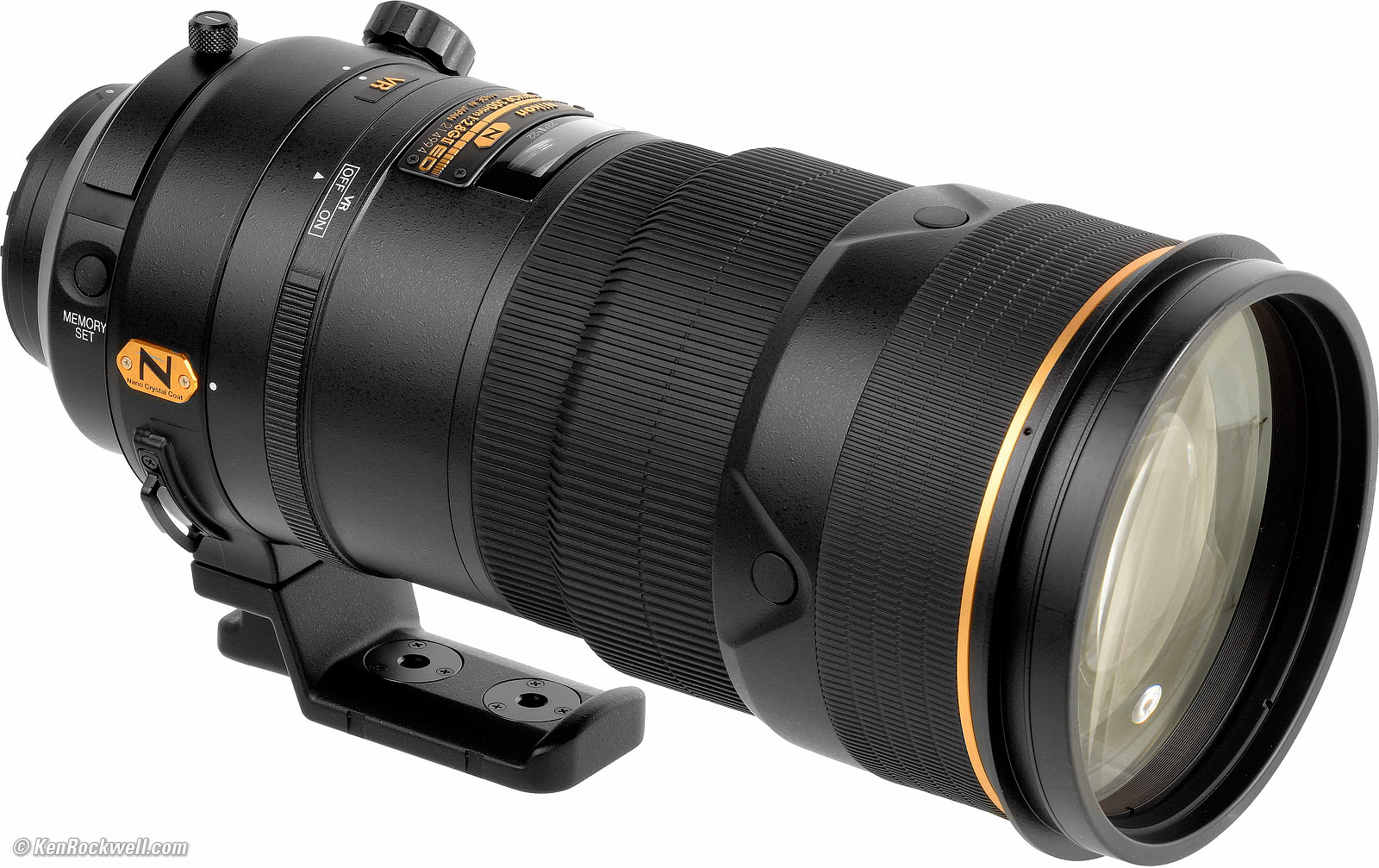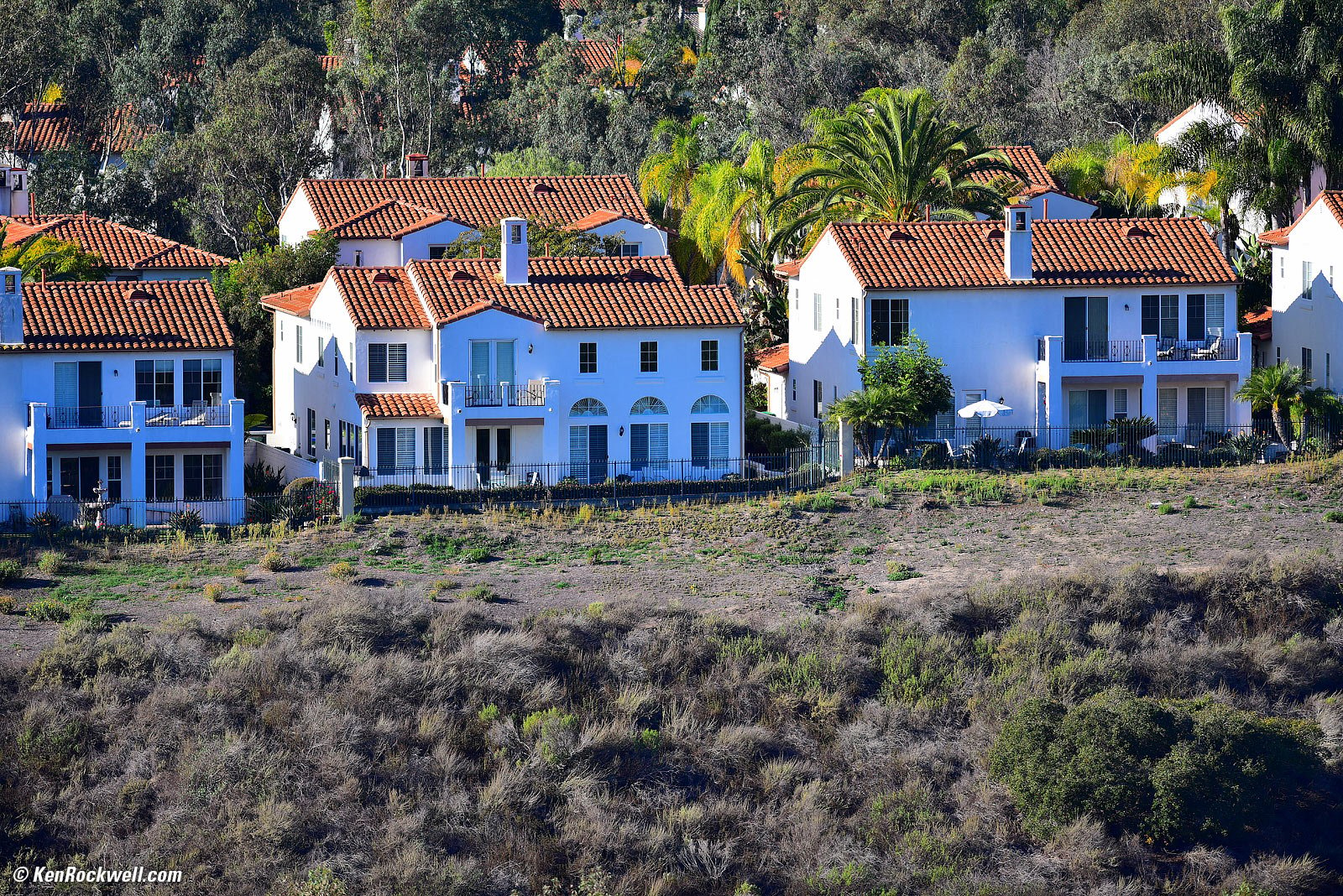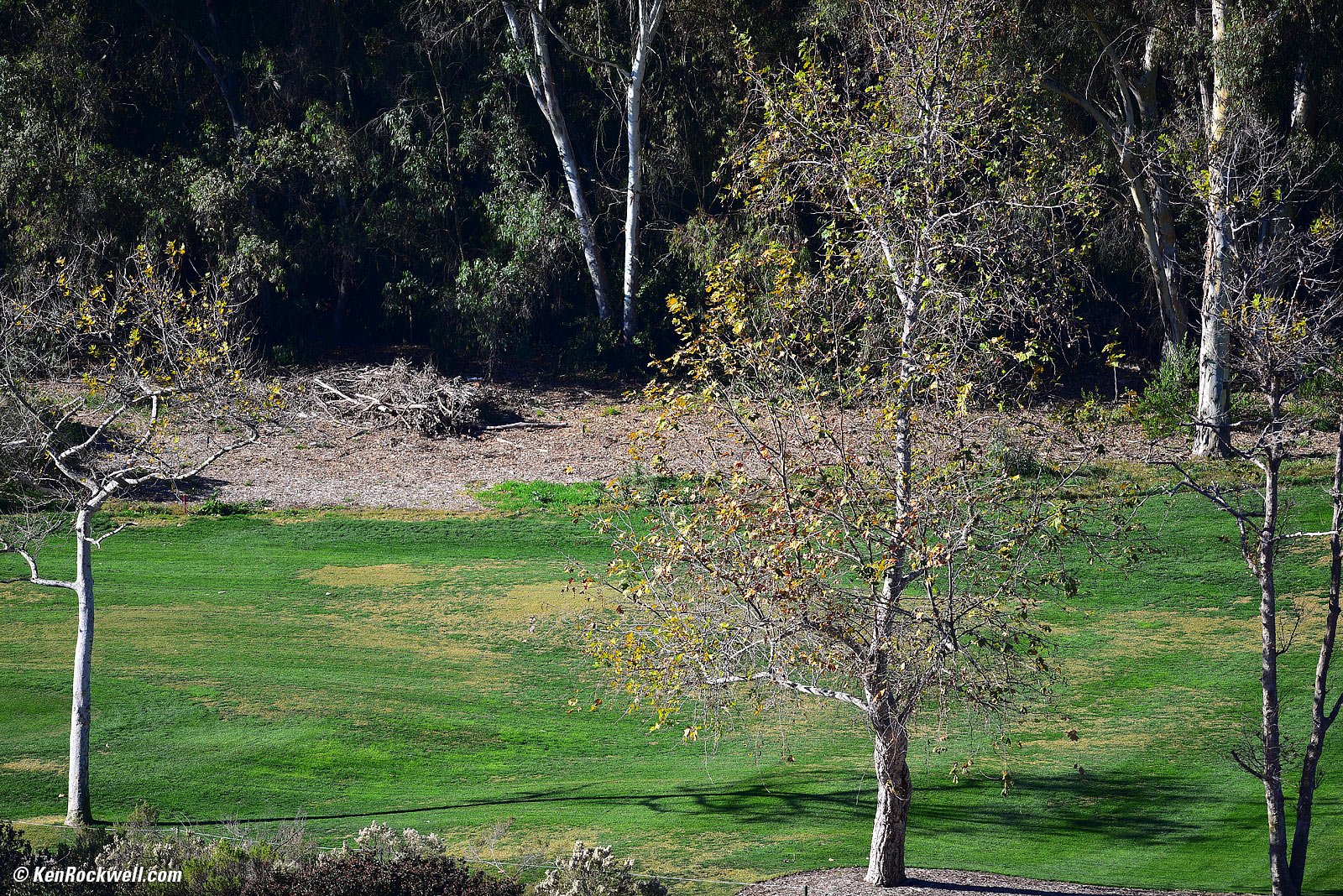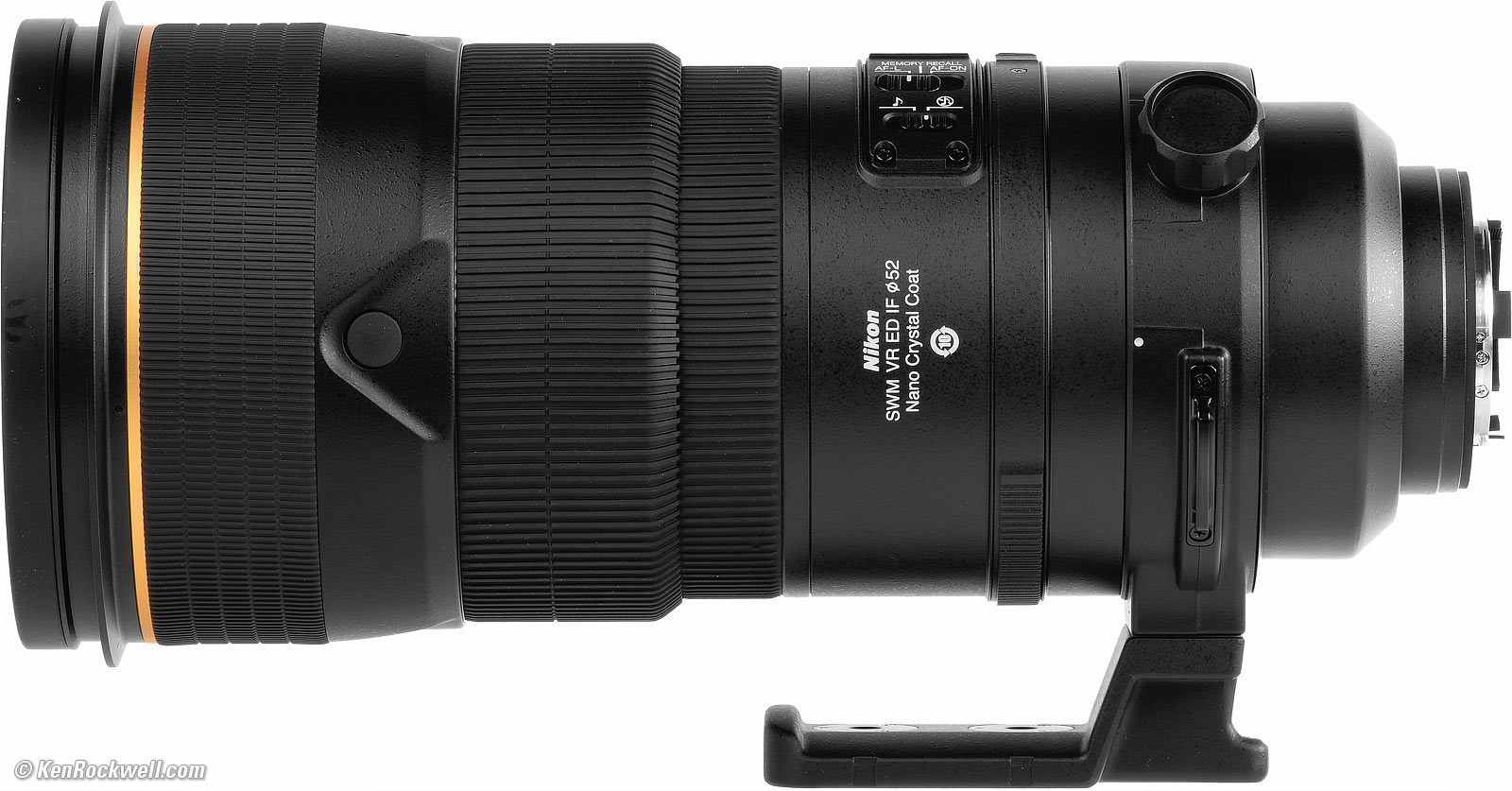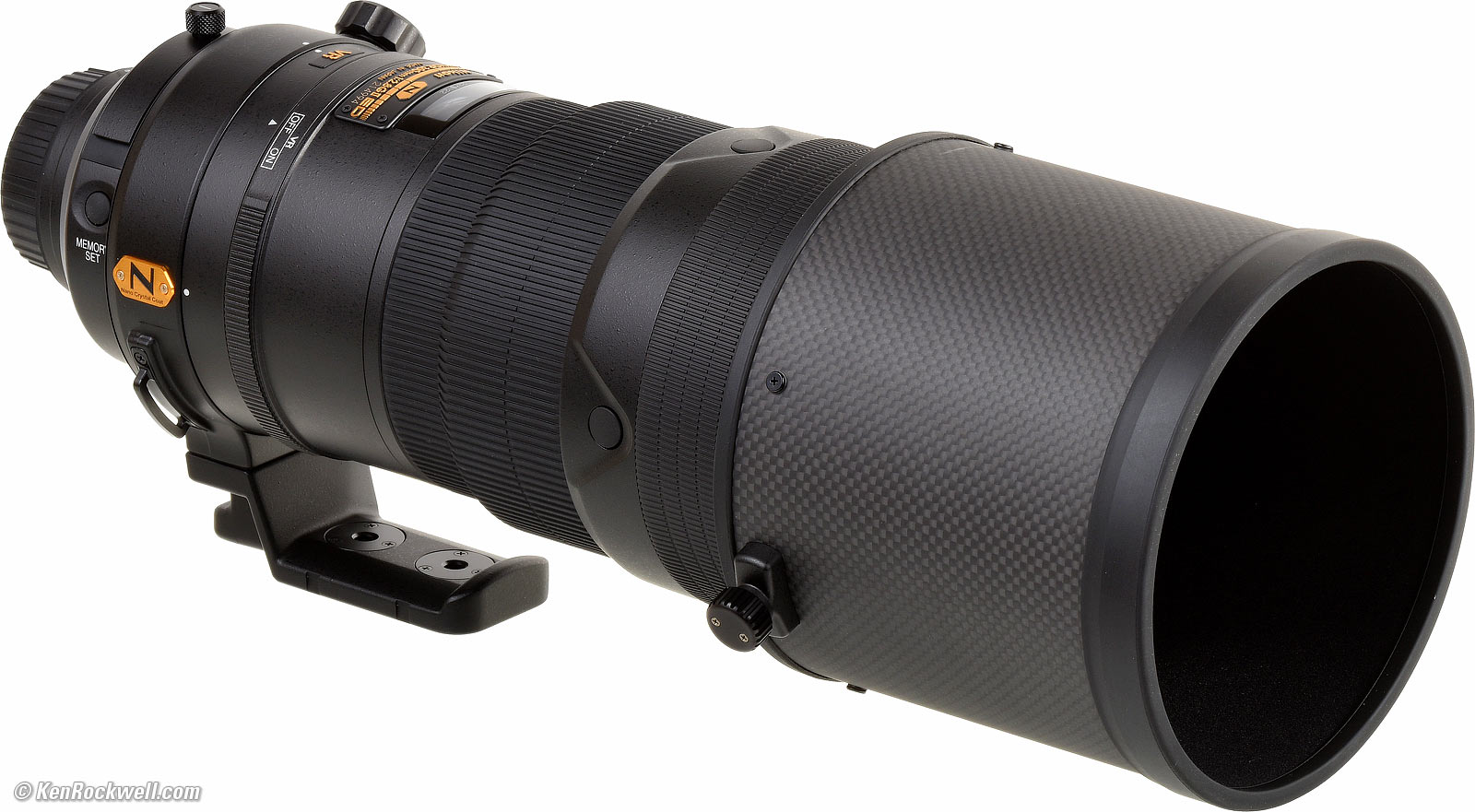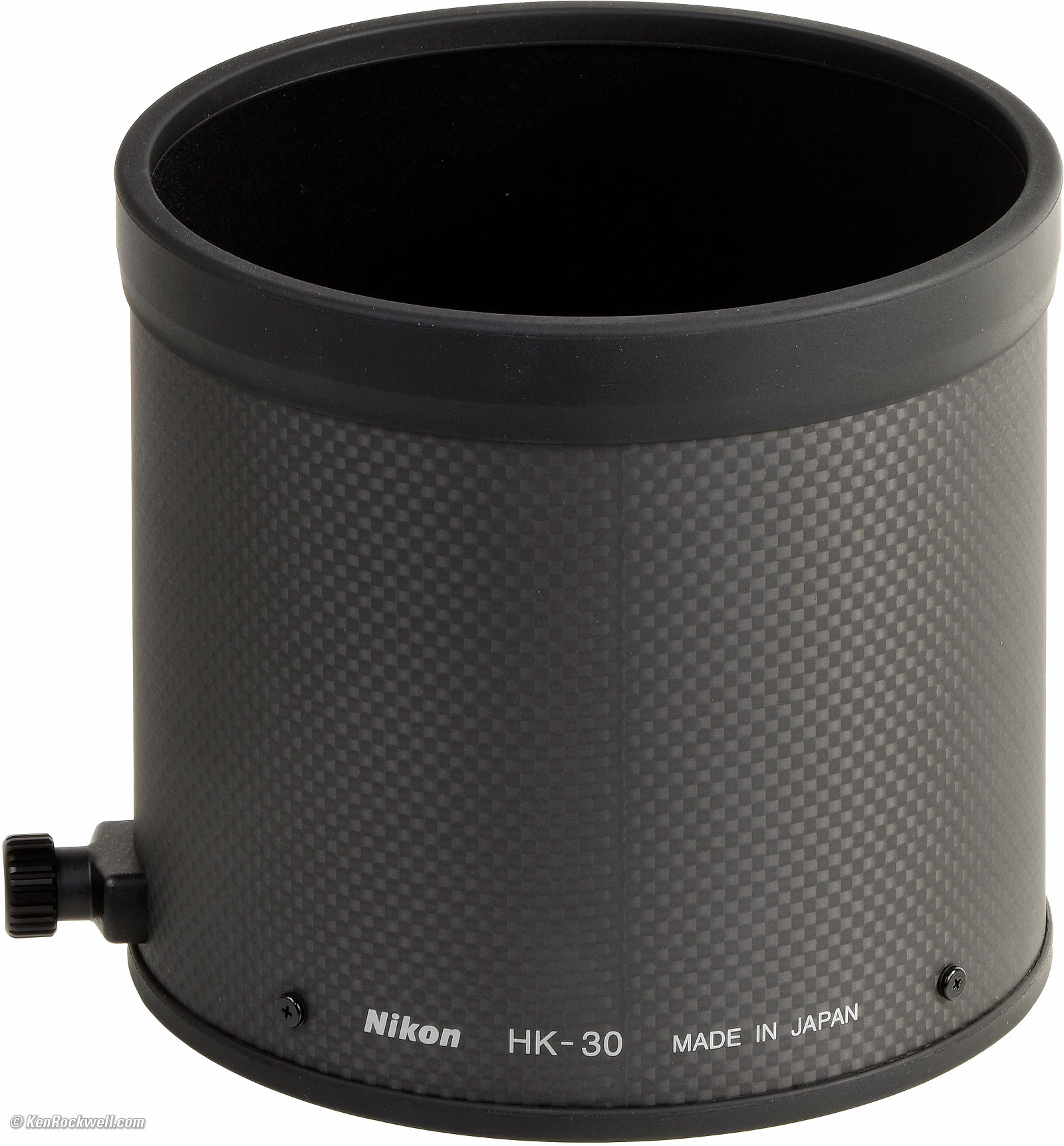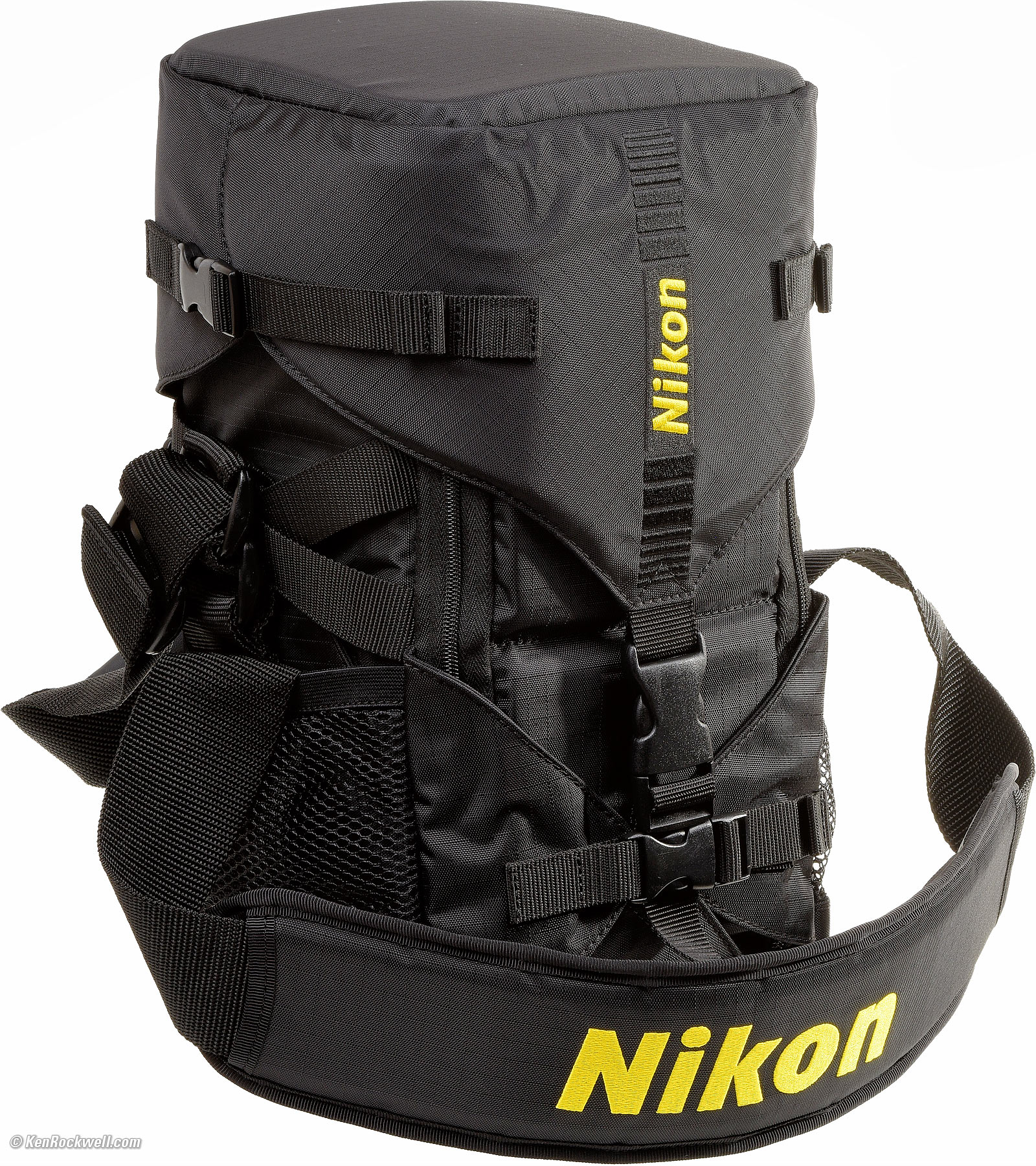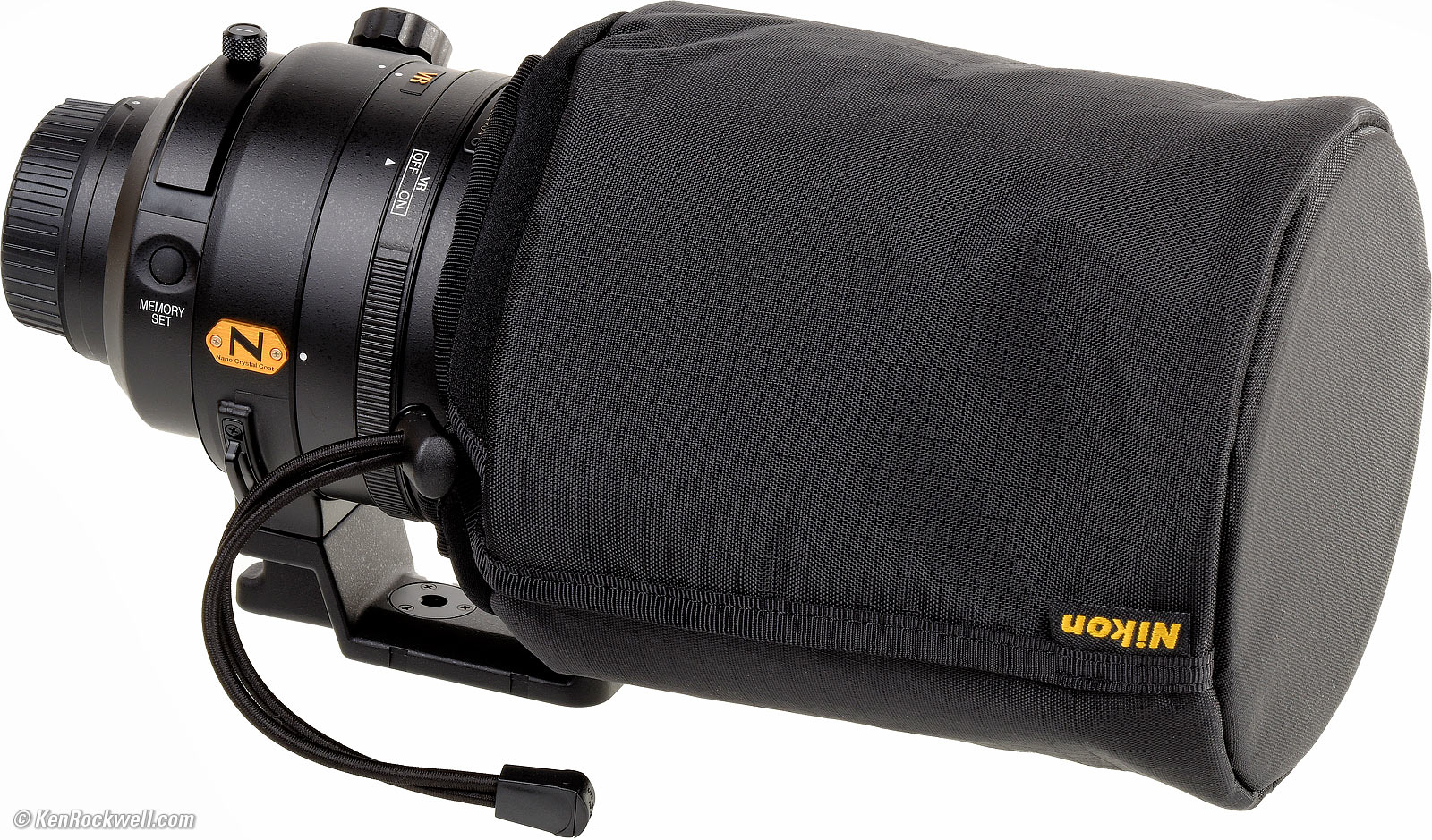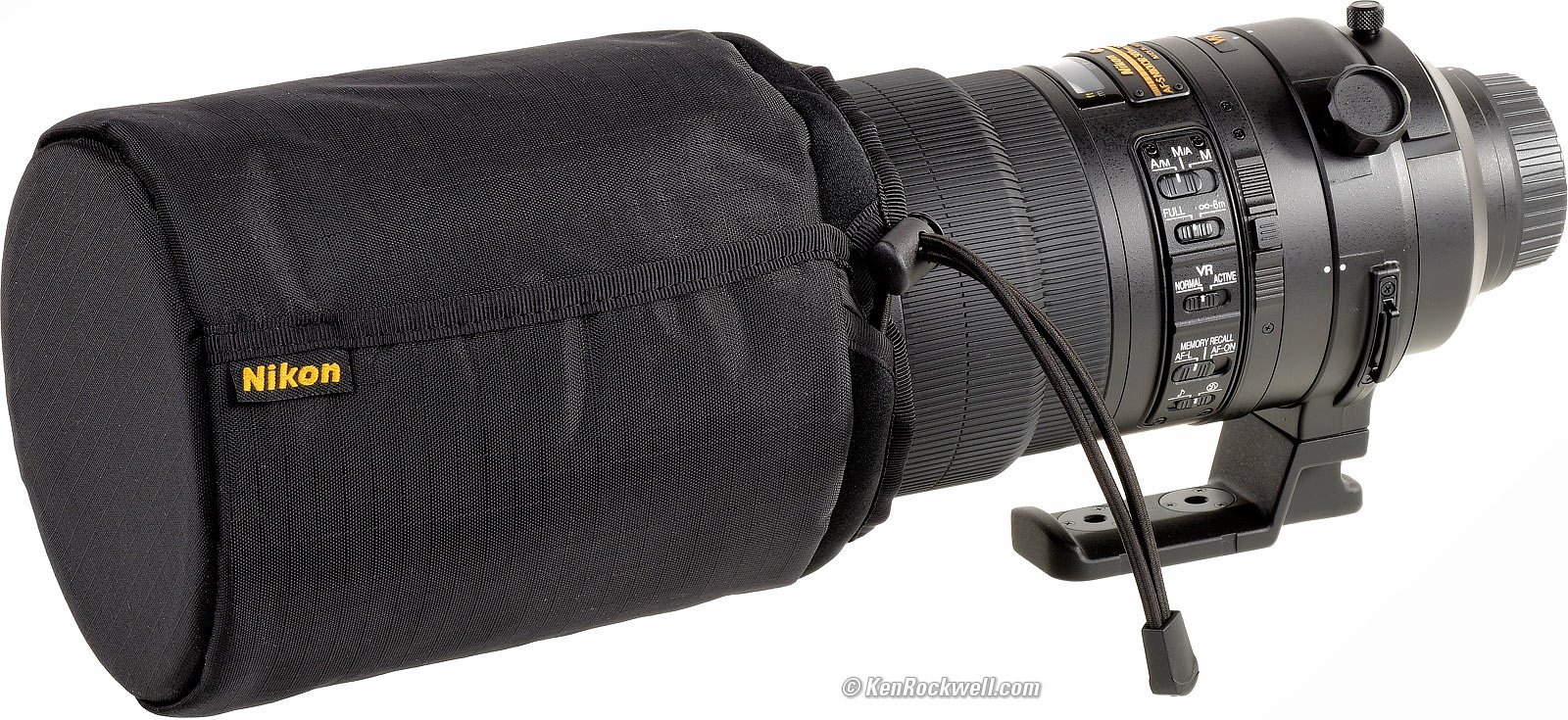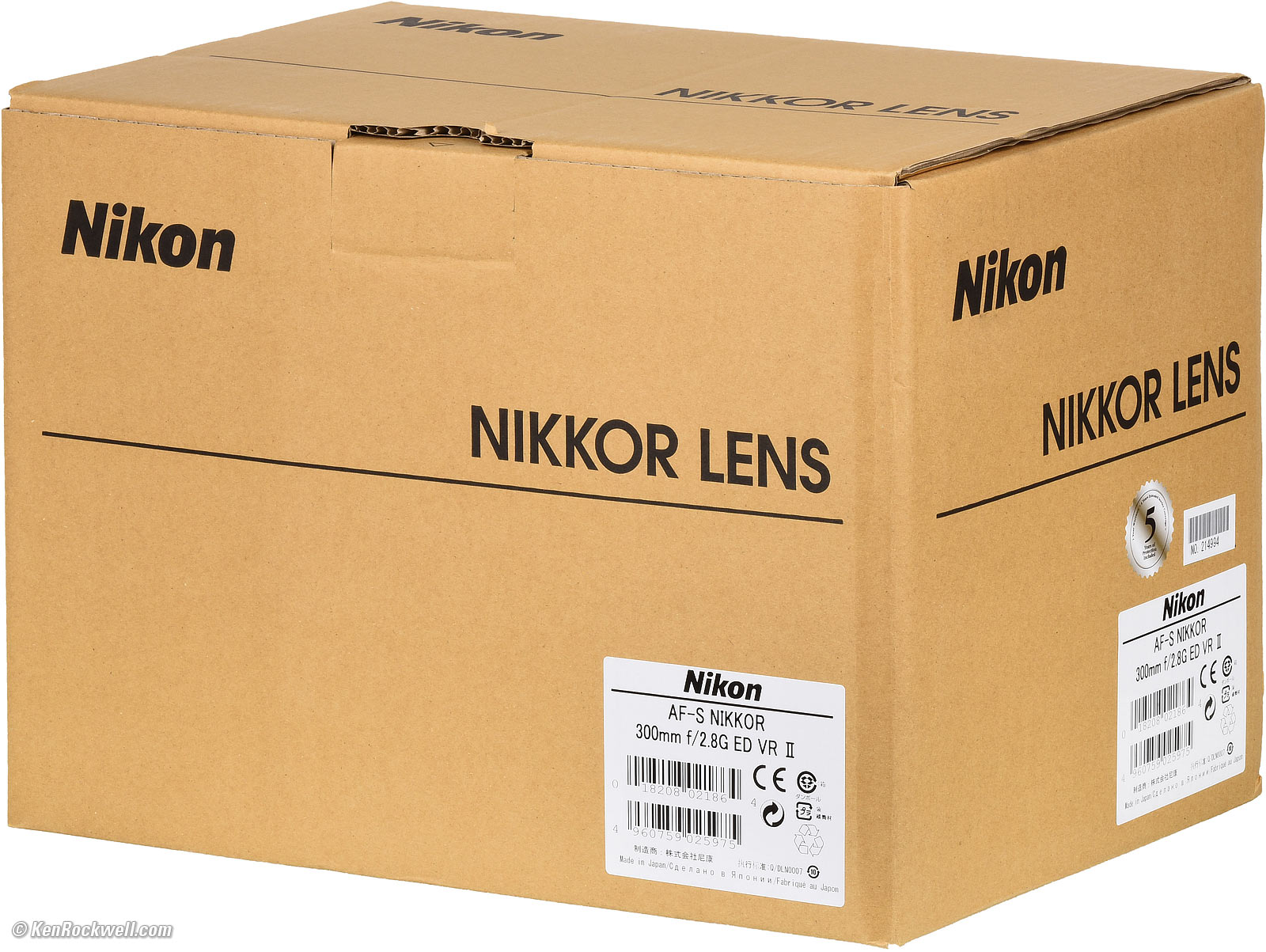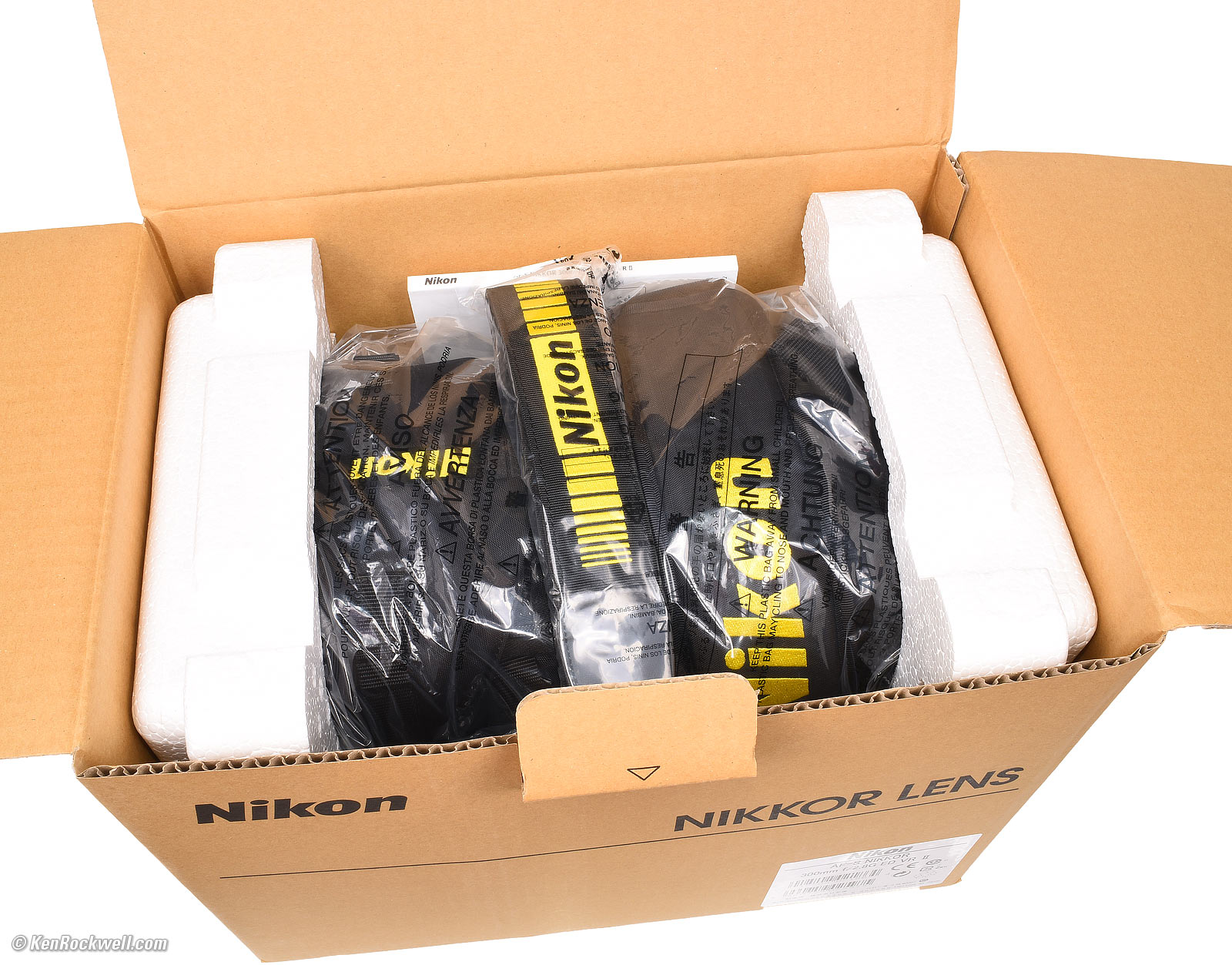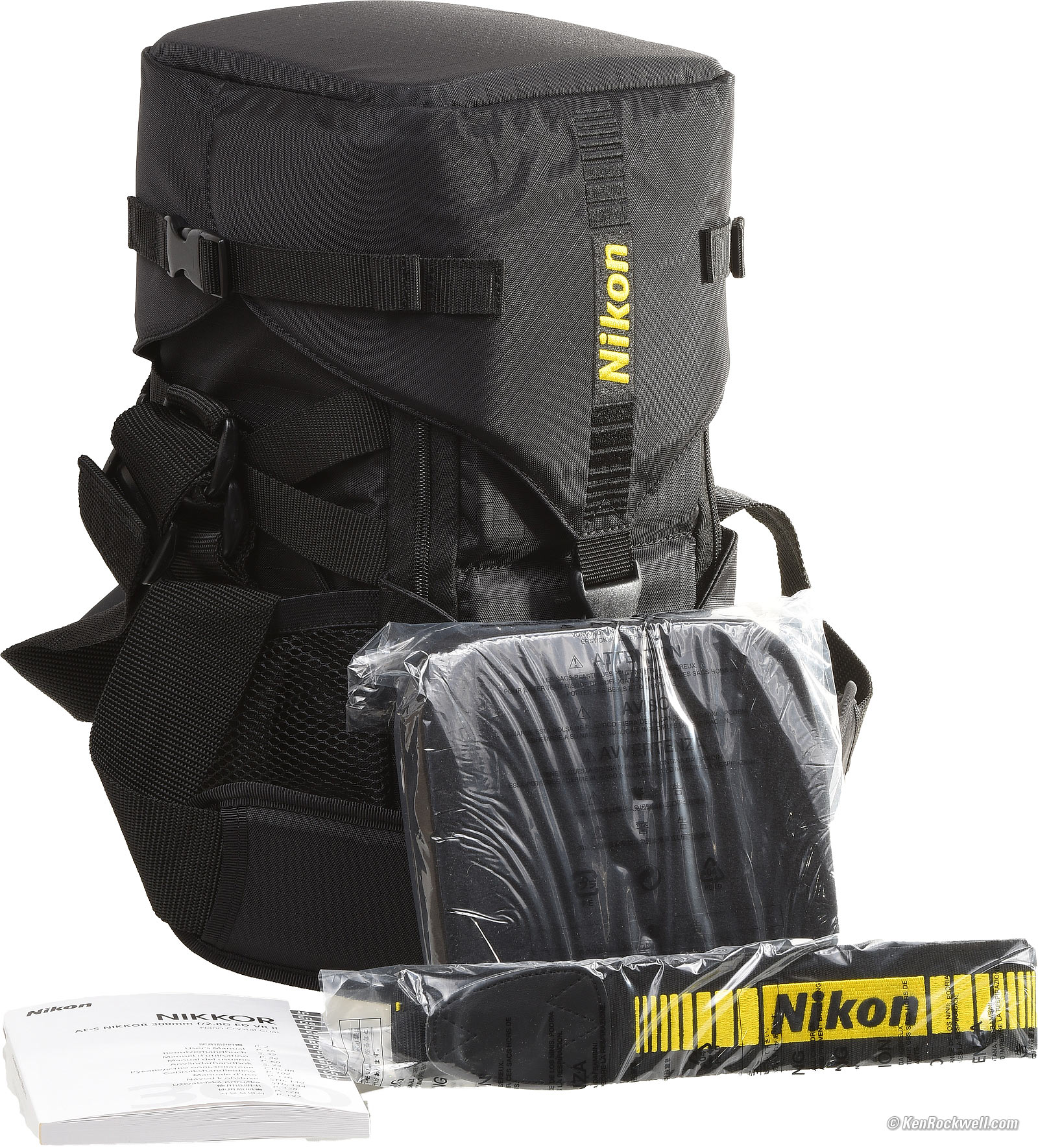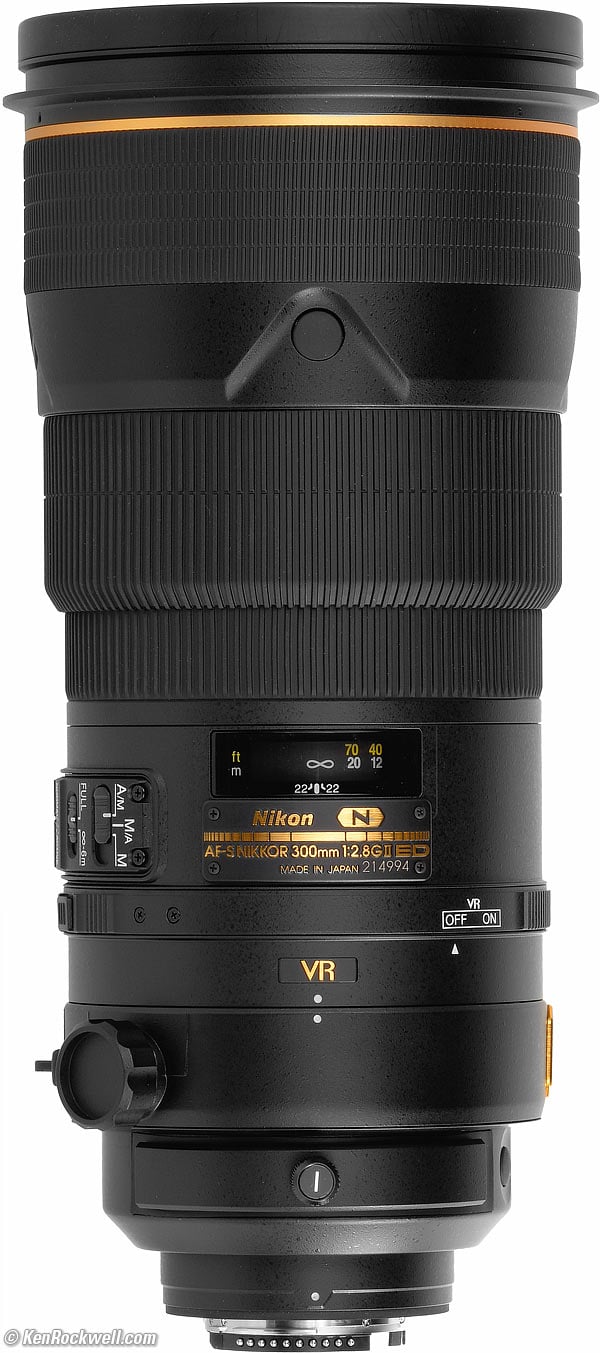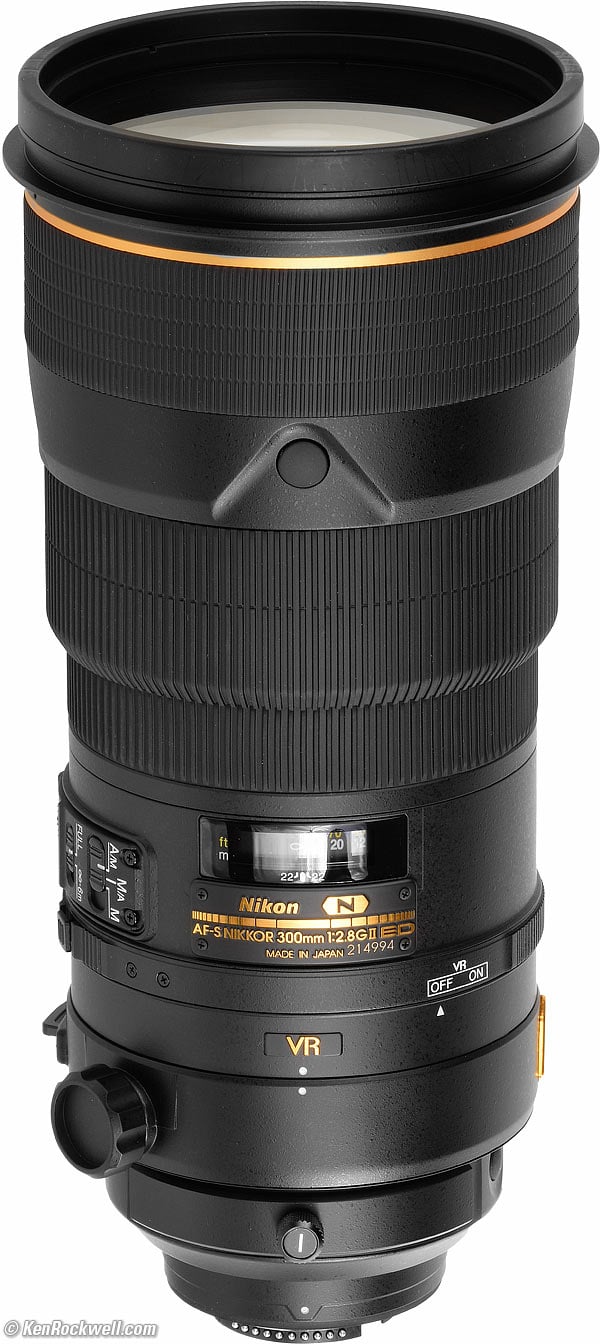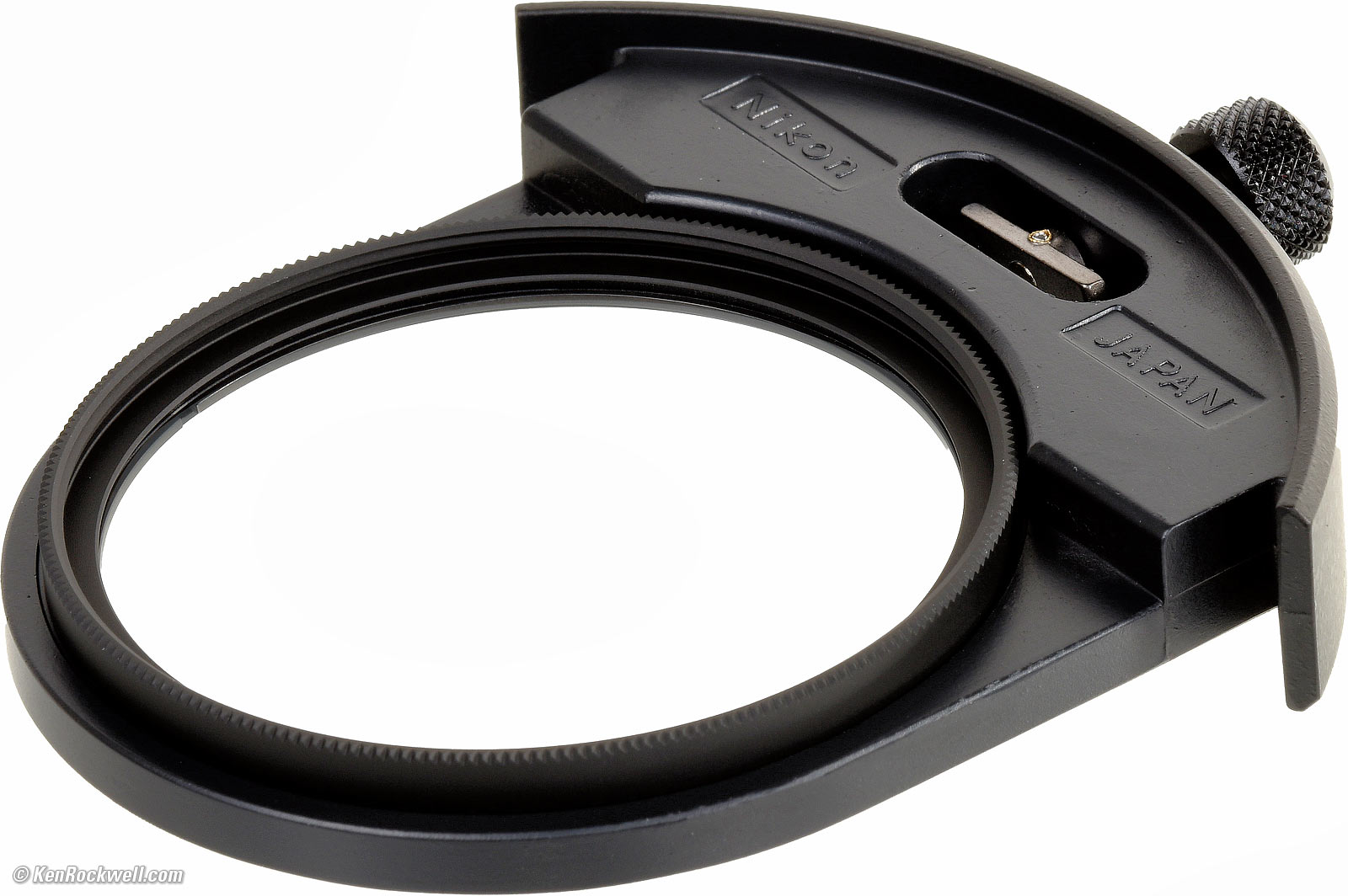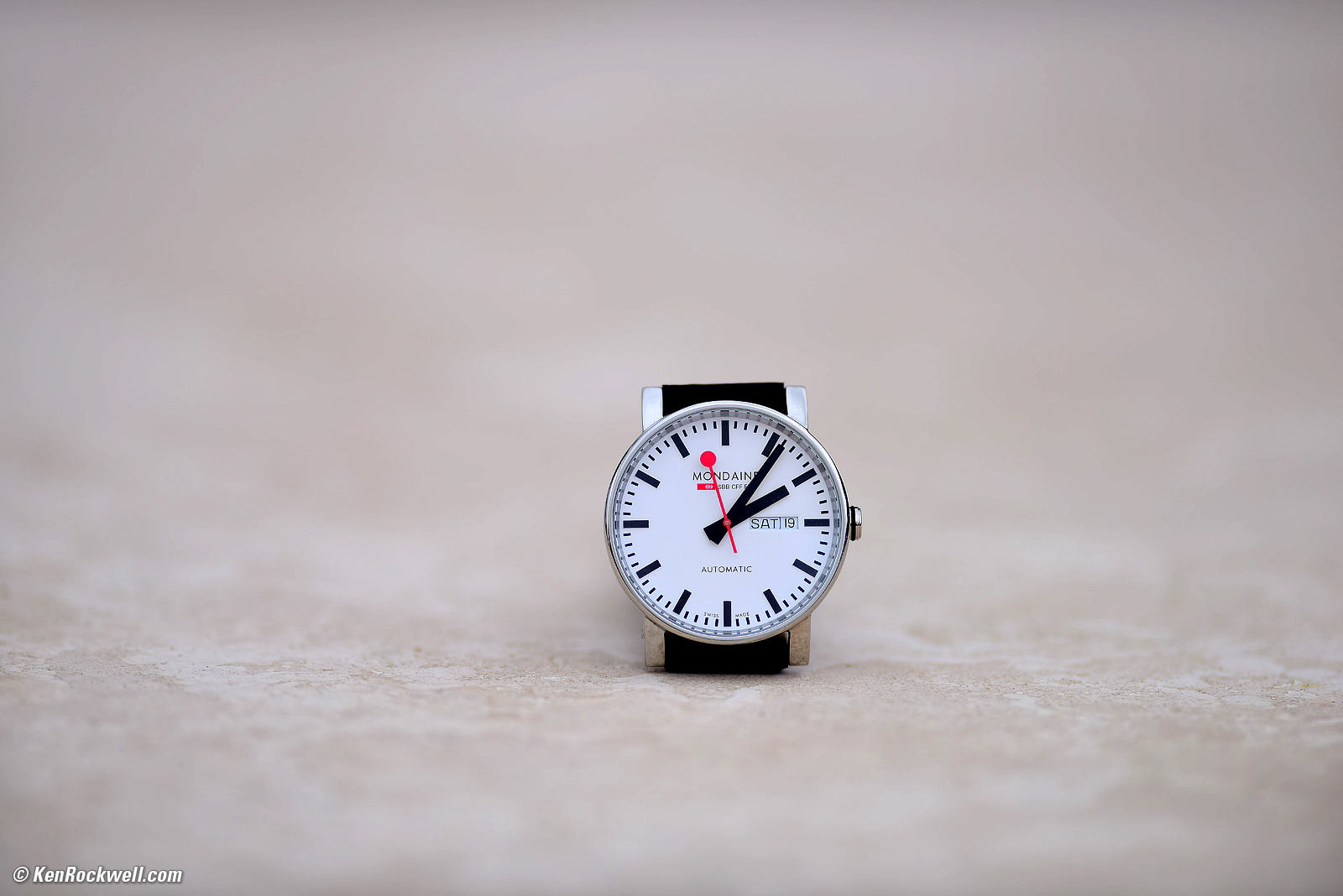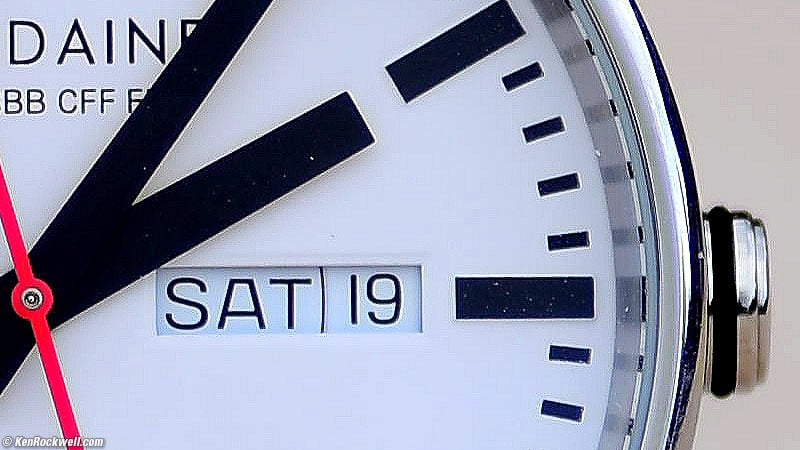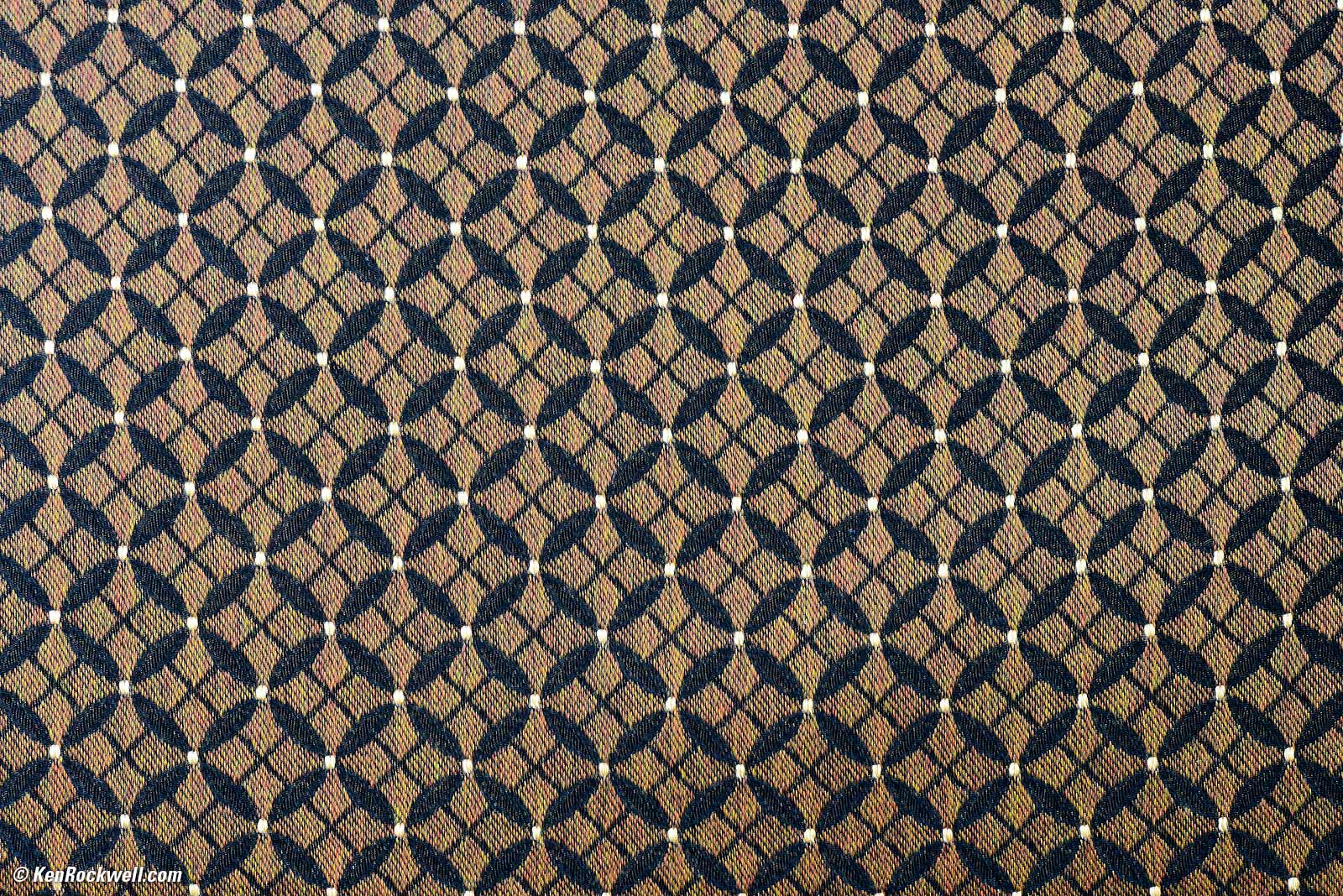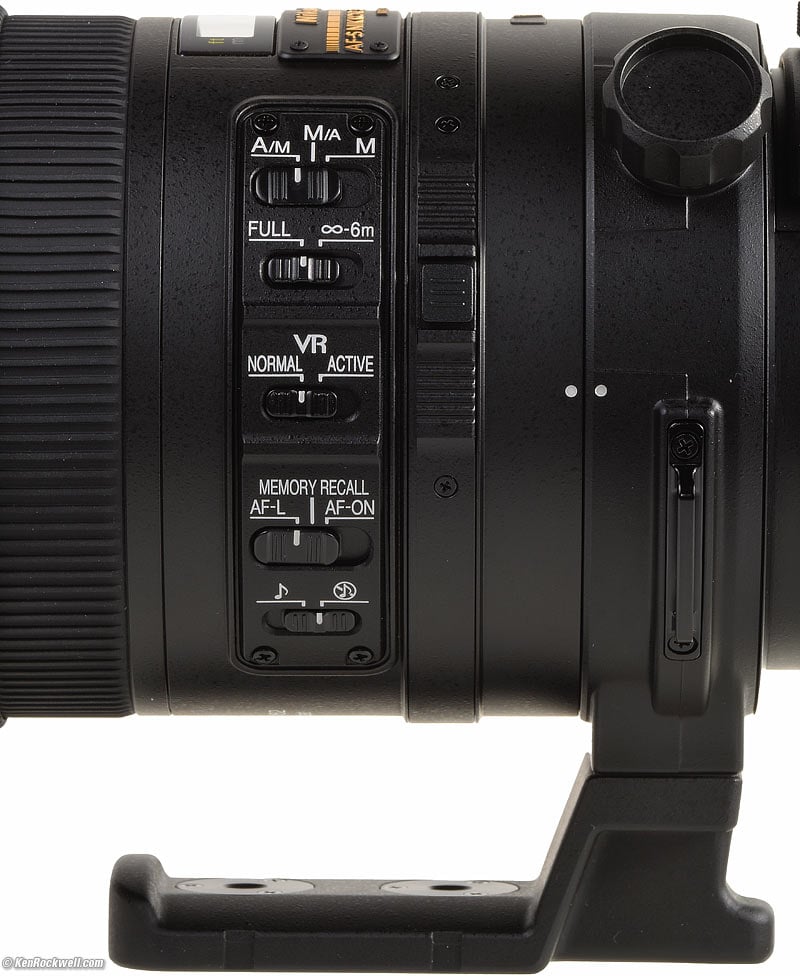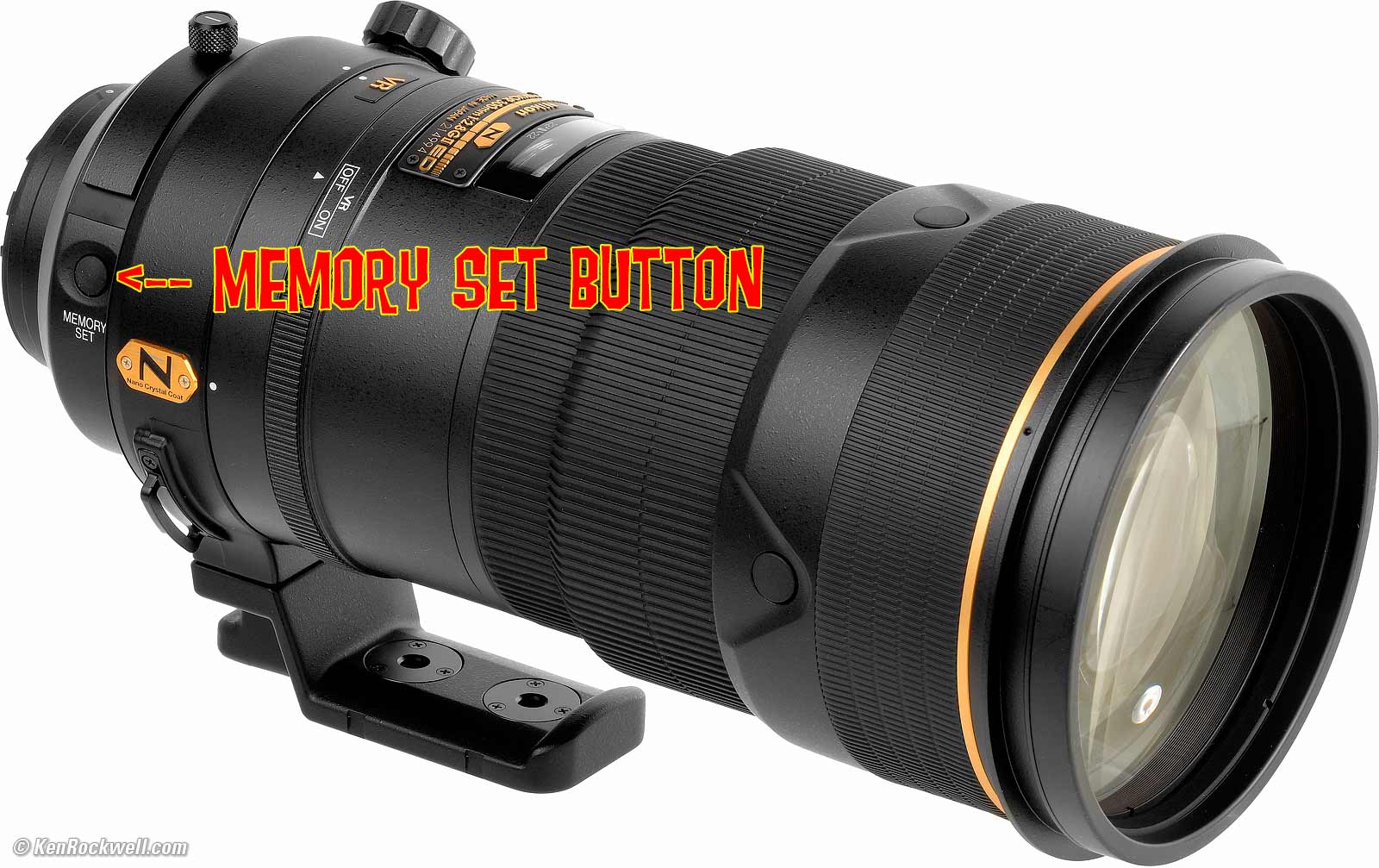Nikon 300mm f/2.8 VR II
AF-S SWM FX ED IF N (2009-)
Sample Images Intro History Compatibility Specs
Performance Compared Usage Recommendations More
Nikon AF-S NIKKOR 300mm f/2.8 VR II (52mm filters, 102.3 oz./2,900 g, 8'/2.2m close focus, about $5,497). bigger. I got mine at B&H. I'd also get it at Adorama or at Amazon.
This all-content, junk-free website's biggest source of support is when you use those or any of these links to my personally-approved sources when you get anything, regardless of the country in which you live. This is a $5,500 lens, and Nikon does not seal its boxes in any way, so never buy at retail or any other source not on my personally approved list since you'll have no way of knowing if you're missing accessories, getting a defective, damaged, used, returned, store demo or used lens. Buy only from the approved sources I use myself for the best prices, service, return policies and selection. Thanks for helping me help you! Ken.
Adorama pays top dollar for your used gear, especially your older 300mm lens, as well as for all Nikon lenses.
January 2020 Better Pictures Nikon Reviews Nikon Lenses Nikon Manual-Focus Lenses All Reviews
Nikon 300mm f/2.8 Comparisons and History
Sample Images
Top Sample Images Intro History Compatibility Specs
Performance Compared Usage Recommendations More
Test image at 500 meters, wide-open at f/2.8! D810, 300/2.8 VR II, f/2.8 at 1/1,000 at ISO 100. bigger or full-resolution file from a camera JPG to explore on your computer (mobile devices rarely can display the full resolution).
Test image at 200 meters, wide-open at f/2.8! D810, 300/2.8 VR II, f/2.8 at 1/1,000 at ISO 100. bigger or camera-original JPG file to explore on your computer (mobile devices rarely can display the full resolution).
It takes one heck of a lens to be this sharp wide-open, all the way out to the corners as it is in both these images. This is exceptional performance; lesser lenses would have to be stopped down and still might not be this sharp.
Introduction
Top Sample Images Intro History Compatibility Specs
Performance Compared Usage Recommendations More
The 300mm f/2.8 is the normal lens of professional sports and paparazzi shooters. It's also one of the most popular portrait and fashion lenses, used to get great facial modeling and completely throw any background out of focus.
This state-of-the-art VR II model is ultra-sharp, especially at f/2.8, and autofocuses just about instantly. If all you've shot before are consumer lenses or zooms, this 300/2.8's autofocus speed will seem unbelievably fast. It also adds better VR than before, too.
Nikon claims three stops of VR improvement.
You can grab the focus ring any time for instant manual-focus override.
There are four AF buttons around the front of the lens which can be set with a switch to be AF stop (AF lock), Focus Memory or AF start.
Focus Memory lets us save and recall any focus distance, like home plate or your bird feeder, immediately.
This lens looks big and scary, but it's easy to hand-hold.
History
Top Sample Images Intro History Compatibility Specs
Performance Compared Usage Recommendations More
Nikon invented the world's first 300mm f/2.8 lens in 1971. It was a hog and no one bought it.
Nikon's first popular 300mm f/2.8 ED-IF came out in 1977. It added internal focusing, so a single fingertip could flick the focus. It was adopted immediately as standard issue for every news and sports photographer. These were extremely popular, but you had to have the skill of a pro to follow-focus manually on sports.
Nikon's first autofocus 300mm lenses from 1986 through 1996 had such horribly slow autofocus that pro sports shooters all moved to Canon, whose AF system and EF 300/2.8 L of 1987 focused much faster than anything from Nikon until 1996!
Nikon considered autofocus just a gimmick for amateurs, and didn't bother to develop it for professional use in the 1980s. Canon thought otherwise in the 1980s, and today we know who guessed right.
Nikon's 300/2.8s have had super-fast AF ever since the first AF-S version of 1996, but few pro sports shooters had any reason to move back to Nikon until the D3 of 2007, after which Nikon and Canon have pretty much shared the pro market.
Compatibility
Top Sample Images Intro History Compatibility Specs
Performance Compared Usage Recommendations More
Everything works perfectly on every digital Nikon, both FX and DX, and even on Nikon's cheapest digitals like the D40, D40x, D60, D3000 and D5000.
It's also perfect on decent or recent AF 35mm cameras like the F6, F100, F5, N80 and N75.
The incompatibilities for older or cheaper 35mm cameras are that:
1.) It won't autofocus with the cheapest new AF 35mm cameras like the N55, but if you focus manually, everything else works great. Even if you lose autofocus, these cameras have in-finder focus confirmation dots to help you.
2.) Late 1980s ~ early 1990s AF cameras like the N90s, N70 and F4 will focus just fine, but you'll lose VR. You'll have Program and Shutter-priority modes, but lose Manual and Aperture-priority since you have no way to set the aperture on the camera or on the lens.
3.) You're really pushing it with the oldest AF cameras like the N2020, N6006 and N8008. You'll have no AF, confused exposure modes, and no VR. Manual focus is fine, along with electronic focus indications.
4.) Since it has no aperture ring, it's just about useless with manual focus 35mm cameras.
See Nikon Lens Compatibility for details with your camera. Read down the "AF-S, AF-I," "G" and "VR" columns for this lens. You'll get the least of all the features displayed in all columns, since "G" (gelding) is a handicap which removes features.
The fancy focus lock, AF start and focus memory functions work perfectly on all digital cameras, as well as the F6, F5, F100, N80/F80, N75/F75, N65/F65 and even the Pronea cameras. They even work on the F4, N90/F90/x and N70/F70, but you may have to be holding the shutter button halfway.
Specifications
Top Sample Images Intro History Compatibility Specs
Performance Compared Usage Recommendations More
I compare specifications of this new VR II to every other Nikon 300mm f/2.8 at 300mm History.
Name
Bottom, Nikon AF-S NIKKOR 300mm f/2.8 VR II. bigger.
Nikon calls this the Nikon N AF-S NIKKOR 300mm f/2.8G ED VR II SWM IF ∅52.
N means nano-crystal coating, a better kind of anti-reflection coating.
AF-S and SWM mean Auto Focus - Silent. The AF motor is a Silent Wave Motor, the same sort of ultrasonic motor Canon uses.
NIKKOR is Nikon's brand name for there lenses ever since 1917.
G means Gelded, or missing its aperture ring.
ED: Extra-low Dispersion glass; magic glass to reduce secondary green-magenta color fringing.
VR: Vibration Reduction, used to steady the image when shooting hand-held or from the back of a motorcycle. This lens uses what Nikon calls version II VR, or VR II.
II: Means version II; the first 300mm f/2.8 VR was made 2004 ~ 2009.
SWM: Silent Wave Autofocus Motor.
IF: Internal focus. Nothing moves externally as focussed.
∅52: Takes standard 52mm filters in a drop-in holder.
Optics

11 elements in 8 groups.
3 are made of magic ED glass.
One has a nano crystal coat, as a marketing feature.
One extra front flat protective plate, easier and less expensive to replace than an actual element.
Focal Length
300mm.
When used on a DX camera, it sees the same angle of view as a 450mm lens sees when used on a 35mm or FX camera.
Angles of View
8.2º on FX.
5.3º on DX.
6.7º on Pronea.
Diaphragm
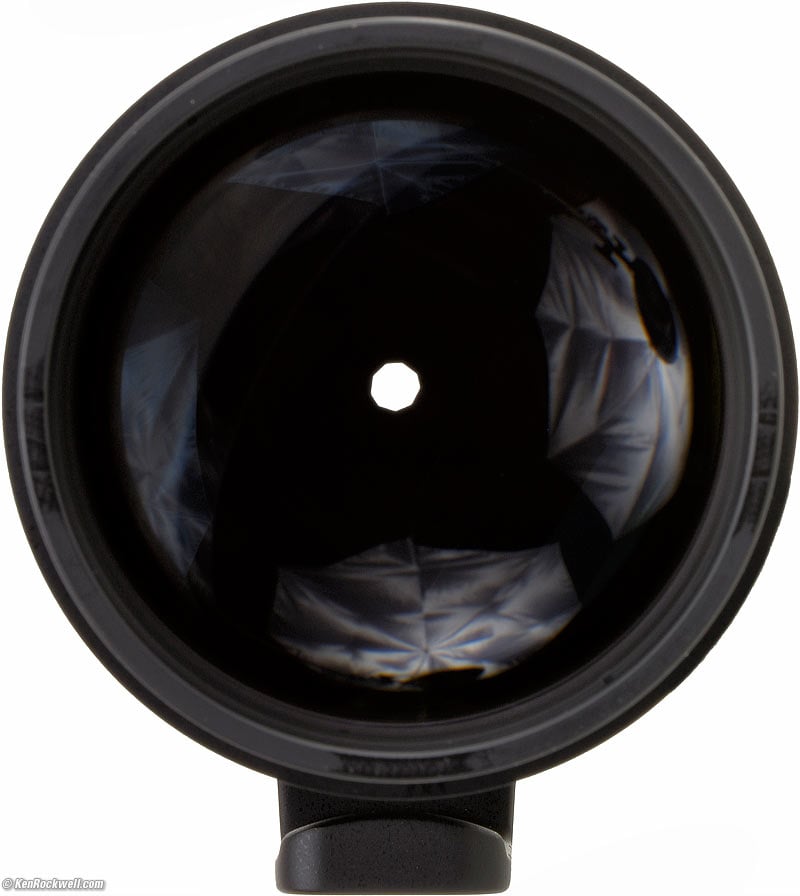
Front, Nikon AF-S NIKKOR 300mm f/2.8 VR II.
9 rounded blades.
Stops down to f/22.
Close Focus
2.3m (2.2m in manual-focus mode).
Maximum Reproduction Ratio
1:6.4.
Filters
Hood
Nikon AF-S NIKKOR 300mm f/2.8 VR II with HK-30 hood. bigger.
HK-30 hood, included.
It attaches in either the extended or reversed positions.
HK-30 hood for Nikon AF-S NIKKOR 300mm f/2.8 VR II. bigger.
Case
CL-L1 padded nylon case, Nikon AF-S NIKKOR 300mm f/2.8 VR II. bigger.
It comes with a big padded case.
There isn't enough room for an attached camera on top; it holds just the lens.
Caps
Nikon AF-S NIKKOR 300mm f/2.8 VR II with padded cap. bigger.
It comes with a padded draw-string front cover, as well as a standard Nikon rear cap.
The front cover works just as well with the hood extended:
Nikon AF-S NIKKOR 300mm f/2.8 VR II with hood extended and padded cap. bigger.
Tripod Collar
It doesn't come off, but a Nikon Service center can take it off for you.
Teleconverters
Use any of the "E" converters, like the TC-14E, TC-17E and TC-20E converters.
It works with all original, -II and -III versions.
It also works with the manual focus converters, but becomes manual focus and you lose all communication and metering with the camera.
Size
4.9" (124mm) diameter x 10.5" (267.5mm) extension from flange.
Weight
102.3 oz. (6.4 pounds or 2.9 kg).
Announced
10 December 2009.
Available
Since January 2010.
Warranty
5 years in USA.
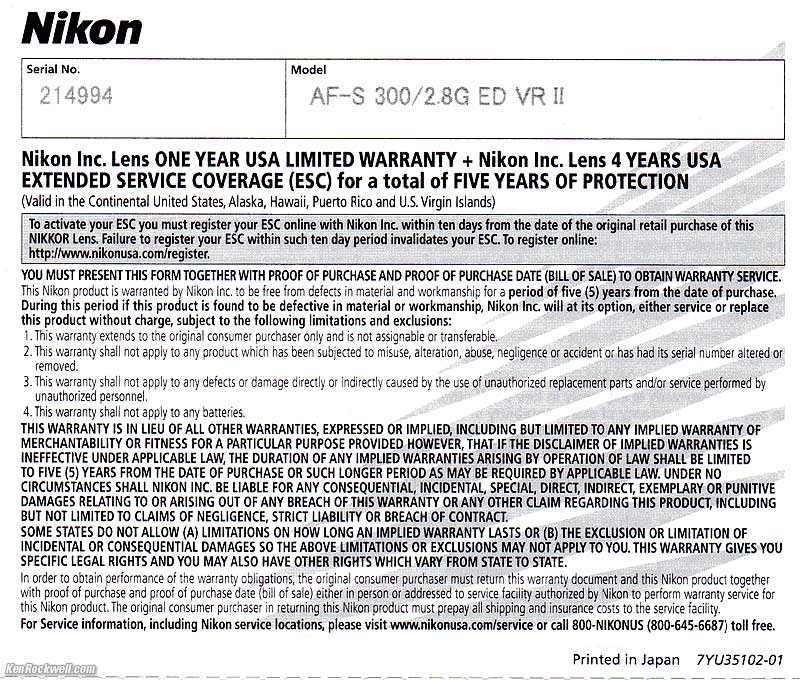
Nikon USA Warranty Card.
If you didn't get one of these cards slipped into your instruction manual, you got ripped-off with a gray-market lens. Buy only from the approved sources I use myself and you won't have to worry.
It has to say 4 YEARS USA EXTENDED on this card to have a valid USA warranty.
Price, USA
$5,497, January 2020
$5,500, Christmas 2015. The growing value of the US dollar is helping us. Not only is this fewer dollars to day than when first introduced, considering inflation, it cost the equivalent of $6,500 back in 2009.
$5,700, November 2011.
$5,900, December 2009.
What's Included
Lens
Semi-soft Case CL-L1 with Strap LN-1
Slip-on front lens cap
Rear Lens Cap LF-1
Lens Hood HK-30
Dedicated filter holder with 52mm Screw-in NC Filter (installed)
Instructions
Nikon 300 2.8 VR II box. bigger.
Opening the Nikon 300 2.8 VR II box. bigger.
What's included with the Nikon AF-S NIKKOR 300mm f/2.8 VR II. bigger.
What looks like a black CD holder is an extra pad if you want things packed more snugly inside the case.
Performance
Top Sample Images Intro History Compatibility Specs
Performance Compared Usage Recommendations More
Overall Autofocus Bokeh Distortion Ergonomics
Falloff Filters Lateral Color Fringes Macro Mechanics
Sharpness Spherochromatism Teleconverters Vibration Reduction
Overall
The 300/2.8 is a professional staple. It is the lens, along with the 70-200mm f/2.8 VR II, by which professionals gauge the entire Nikon system.
Focus
Autofocus
Autofocus is ultra fast. It's so fast you just might not believe how much faster this state-of-the-art professional lens is compared to Nikon's consumer lenses like the 200-500mm and 80-400mm.
This 300/2.8 can rack all the way in and out in the blink of an eye.
Even if this lens weren't so fast and so sharp, you'd want it just because it focuses fast enough to catch whatever you're shooting.
Manual Focus
Manual focus works great. Just slide the big ring with a fingertip.
Bokeh
Bokeh, the quality of out-of-focus areas as opposed to the degree of defocus, is very good. Of course with a 300mm f/2.8, backgrounds are always gone at f/2.8.
Here are samples shot wide open from headshot distance. Click for the camera-original file to explore on your computer (portable devices rarely can display the full resolution of these files):
Shot at f/2.8 on a Nikon D810. bigger or camera-original file to explore on your computer (mobile devices rarely can display the full resolution).
Only the center is in focus, and you'll notice how ultrasharp it is, too.
Distortion
The Nikon 300mm f/2.8 VR II has no visible distortion.
These values in Photoshop's Lens Distortion tool will completely remove the tiny bit of pincushion distortion. These aren't facts or specifications, they are the results of my research that requires hours of photography and calculations on the resulting data.
|
on FX |
3m (10') |
-1.00 |
10m (30') |
-1.00 |
30m (100') |
-1.00 |
infinity |
-0.80 |
© 2015 KenRockwell.com. All rights reserved.
Ergonomics
This is a man-sized lens, and still easy to hand-hold. It's big, but not that heavy. Nikon does its best with titanium and other tricks to keep the weight down for sports, news and paparazzi pros who have to carry this all day, every day.
The four AF buttons at the front always fall right under my thumb, regardless of how I hold it. It has four buttons so there's always one in the right place; they all do the same thing.
The big ribbed two-level ring in the middle is manual focus. It feels just right; just a fingertip will move it.
Falloff
Falloff is completely invisible, except a little at f/2.8. Turn on Vignette Correction and it goes away.
I've greatly exaggerated this by shooting a gray field and showing it on a gray background:
Nikon 300mm f/2.8 VR II falloff, uncorrected on FX
© 2015 KenRockwell.com. All rights reserved.
|
Filters, use with
Drop-in 52mm filter holder, Nikon AF-S NIKKOR 300mm f/2.8 VR II. bigger.
It takes standard screw-in 52mm filters in a drop-in holder.
If the filters are too thick, they won't slip through the slot on the lens even though they'll attach just fine to this holder. Stick with Nikon brand filters, which are thin enough.
The lens' optical design expects a filter to be there, and Nikon graciously includes a 52mm NC (no color) filter with your lens.
If you need a polarizer, use the C-PL1L.
No gelatin filter holder is included, but I suspect you can use the same holder that Nikon has been using since the 1970s. You need the larger 52mm version, not the smaller 39mm version. The one above measures 58.8 mm across the flats.
Lateral Color Fringes
There are no color fringes as shot on my D810, which automatically corrects any that may be there.
This is superb performance, as expected.
Macro
This lens doesn't get very close; my iPhone does much better:
Mondaine A1323034811SBB at close-focus distance wide-open at f/2.8. bigger or full-resolution to explore on your computer (most portable devices can't show all the pixels in the full resolution file).
Crop from above at 100%. If this is about 8" (20cm) on your screen, printing the complete image at this same high magnification would result in a 50 x 75" (125 x 200 cm) print! Full-resolution file to explore on your computer (most portable devices can't show all the pixels in the full resolution file).
To get results this sharp at f/2.8 you need perfect focus, otherwise you'll get some color fringes due to spherochromatism.
Mechanics
Nikon 300 2.8 VR bigger.
The 300 2.8 is one of Nikon's very top pro lenses. It's still made like they used to: all metal!
Front Bumper
Rubber.
Hood Mount
Metal.
Front Barrel
Metal.
Focus Ring
Rubber-covered metal.
Mid Barrel (holds focus window)
Metal.
VR ON/OFF Ring
Metal.
Tripod Collar, Lock Knob and Foot
All metal.
The two ¼-20" tripod sockets are each individually held in with three screws so they can be replaced in case of wear from heavy professional use.
Internals
Seem like all metal.
Rear Barrel
Metal.
Identity
Metal plate held on with four screws.
Painted black, with raised gold highlights.
Moisture seal at mount
Yes.
Mount
Chromed metal.
Markings
Painted.
Serial Number
Laser-engraved in gold into identity plate.
Date Code
None found.
Noises When Shaken
Some metallic clanking, presumably from the VR unit.
Made in
Japan.
Sharpness
Image sharpness depends more on you than your lens, and lens sharpness doesn't mean much to good photographers. It's the least skilled hobbyists who waste the most time blaming fuzzy pictures on their lenses, while real shooters know that few photos ever use all the sharpness of which their lenses are capable due to subject motion and the fact that real subjects are rarely perfectly flat.
This said, this is sharper than any Nikon lens other than the other fast fixed ultrateles. Look at the Sample Images; it's ultra-sharp out to the corners — wide-open!
It's ultrasharp and contrasty right out to the full-frame edges at f/2.8. The other Nikon 300 2.8s have also been stunners like this since the late1970s; I'd be surprised if this lens was anything short of stellar.
As all of Nikon's 300mm f/2.8 EDs have been, performance is exceptional, even shot wide-open. Anything that's not sharp is your fault, not the lens.'
Nikon's MTF curves confirm this; its essentially optically perfect:
Nikon's MTF chart. explanation.
Spherochromatism
The 300/2.8 has no spherochromatism, except at the very closest focus distance.
Spherochromatism, also called "color bokeh" by laymen, causes colored fringes on slightly out-of-focus highlights, usually seen as green fringes on backgrounds and magenta fringes on foregrounds.
It is an advanced form of chromatic aberration in a different dimension than lateral color. Spherochromatism is most commonly seen in fast lenses of moderate focal length when shooting contrasty items at full aperture.
Only at macro distances there is some very minor blue/yellow-green spherochromatism. It goes away as stopped down and it's invisible at normal distances.
Teleconverters
It focuses very quickly with my Nikon TC-20E.
Here's a sample shot wide-open at 550 meters:
Test image at 550 meters, wide-open at 600mm at f/5.6! D810, 300/2.8 VR II with Nikon TC-20E, f/5.6 at 1/250 at ISO 100. bigger or full-resolution file from a camera JPG to explore on your computer (mobile devices rarely can display the full resolution).
It's sharp where I need it sharp, but the sides and corners aren't as sharp if you get out the microscope. We expect this; if you really want to shoot at this long focal length, get a longer lens or just save money and grab the 200-500mm used without a converter instead.
How sharp is it? You can clearly see the zip ties the suburbanite used to attach the wire mesh to his fence, and clearly see each and every wire in that mesh from a third of a mile away! Those wires are only about 1/64 of an inch (half a millimeter) in diameter!
Vibration Reduction
Vibration Reduction (Image Stabilization), rated three stops improvement, can be superb at foolishly slow handheld speeds like 1/8 through 1/4 second. Here's a shot made at a quarter-second hand held, standing with no support:
Puffy cushion shot hand-held at 1/4 second, standing. D810, ISO 100, f/16 at 1/4. bigger.
The gotcha is that VR sometimes doesn't work that well at transitional speeds like from 1/60 through 1/30. It's certainly better than nothing, but if you're picky, it's not always as good as I'd like it at the speeds where it should work perfectly.
When you get yours, be sure to try it out at 1/60 and be sure all your shots are sharp.
It does work swell on a tripod; it figures out that I'm on a tripod and compensates accordingly. There's no need to turn it off unless you're on an exceptionally sturdy support system.
Compared
Top Sample Images Intro History Compatibility Specs
Performance Compared Usage Recommendations More
See Nikon 300mm f/2.8 Comparisons and History.
Compared to the previous 300mm f/2.8 VR, this has improved VR.
This is the best you can get for Nikon, but compared to Canon's current 300/2.8 IS L II, the Canon sells for a little more, but focuses closer (6.6'/2m vs. 8'/2.2m), weighs less (82.9 oz/2.35 kg vs. 102.3 oz./2.9 kg) and undoubtedly has none of the VR problems I see with this lens at moderate speeds.
Usage
Top Sample Images Intro History Compatibility Specs
Performance Compared Usage Recommendations More
Nikon AF-S NIKKOR 300mm f/2.8 VR II. bigger.
Nikon AF-S NIKKOR 300mm f/2.8 VR II controls.
A/M, M/A, M
A/M: Auto Focus. You can override the focus manually by turning the focus ring, but it will try to ignore minor accidental bumps.
M/A: Auto Focus. You can override the focus manually by turning the focus ring, even a little. It will respond even to minor turns of the ring.
M: Manual Focus only.
Full ∞-6m
This is a focus range limiter.
FULL: leave it here.
∞-6m prevents the lens from focussing closer than 6 meters (20 feet). Use this only if the lens is either hunting over a large range looking for things that aren't there, or if there are things closer to the lens than 20 feet which are distractions and not your intended subject.
Also check this switch if for some reason your lens isn't focussing closer than 20 feet.
VR
This switch only optimizes the VR system depending on what you're shooting. The VR system turns on and off with the big ring that encircles the lens just behind these switches.
Leave VR ON on a tripod or monopod. Turn it off only if you are using an extraordinarily solid support.
NORMAL is normal. Leave it here. Use this also for panning shots.
ACTIVE is for shooting from a moving platform like a van or a motorcycle. Use this and VR even if you've mounted the camera on the vehicle.
AF-L MEMORY RECALL AF-ON
Nikon forgot to label this switch as the AF BUTTON FUNCTION. This sets what the four little rubber buttons around the front of the lens do.
AF-L is what I use. Pressing any of the buttons locks focus. I use this as things get in the way of a moving subject as I track it around, or if I want to set portrait focus and recompose.
AF ON turns the four front AF buttons into AF ON buttons.
MEMORY RECALL lets us save and recall a distance, like home plate or the bird feeder. Once saved, tap any of the four front buttons and the lens immediately refocuses to that distance.
Nikon 300/2.8 VR II Memory Set Button. bigger.
To use the MEMORY RECALL:
1.) Be sure the slide switch is set to MEMORY RECALL.
2.) Focus on your preferred subject.
3.) Press the MEMORY SET BUTTON.
4.) To recall the set distance, tap any of the four front AF buttons. You don't need to hold it; one tap and it will spin all the way to your set distance.
♪ ∅
This switch turns the beep on and off when using memory recall focus.
Recommendations
Top Sample Images Intro History Compatibility Specs
Performance Compared Usage Recommendations More
This is a superb lens, especially for full-time pros who know what they want. It's the best you can get for Nikon.
I carry this in my Think Tank Airport Commuter bag.
I would dump anything before the 1996 AF-S version. The older AF-I and AF versions autofocused so poorly that they are why pro sports photographers went to Canon in the early 1990s.
More Information
Top Sample Images Intro History Compatibility Specs
Performance Compared Usage Recommendations More
© Ken Rockwell. All rights reserved. Tous droits réservés. Alle Rechte vorbehalten.
Help Me Help You
I support my growing family through this website, as crazy as it might seem.
The biggest help is when you use any of these links when you get anything. It costs you nothing, and is this site's, and thus my family's, biggest source of support. eBay is always a gamble, but all the other places always have the best prices and service, which is why I've used them since before this website existed. I recommend them all personally.
If you find this page as helpful as a book you might have had to buy or a workshop you may have had to take, feel free to help me continue helping everyone.
If you've gotten your gear through one of my links or helped otherwise, you're family. It's great people like you who allow me to keep adding to this site full-time. Thanks!
If you haven't helped yet, please do, and consider helping me with a gift of $5.00.
As this page is copyrighted and formally registered, it is unlawful to make copies, especially in the form of printouts for personal use. If you wish to make a printout for personal use, you are granted one-time permission only if you PayPal me $5.00 per printout or part thereof. Thank you!
Thanks for reading!
Mr. & Mrs. Ken Rockwell, Ryan and Katie.
